Hand Hygiene Assignment: Preventing Hospital-Acquired Infections
VerifiedAdded on 2022/09/27
|7
|1761
|26
Report
AI Summary
This report delves into the crucial role of hand hygiene in preventing hospital-acquired infections (HAIs). It begins with a PICO (Patient, Intervention, Comparison, Outcome) question framework to structure the analysis, highlighting how proper hand hygiene reduces infection risks like eye and respiratory infections, and decreases healthcare costs. The report explores interventions such as handwashing techniques, surgical hand scrubs, and adherence to WHO guidelines. It emphasizes the importance of standardized procedures and the use of alcohol-based hand rubs. The outcome section underscores the reduced bacterial content on hands and decreased infection rates. The search strategy details the methods used to gather evidence, including the use of Boolean operators, truncation, and restriction to meta-analyses and systematic reviews, ensuring the reliability of the findings. References to key studies are provided to support the conclusions, underscoring the significance of hand hygiene in healthcare settings.
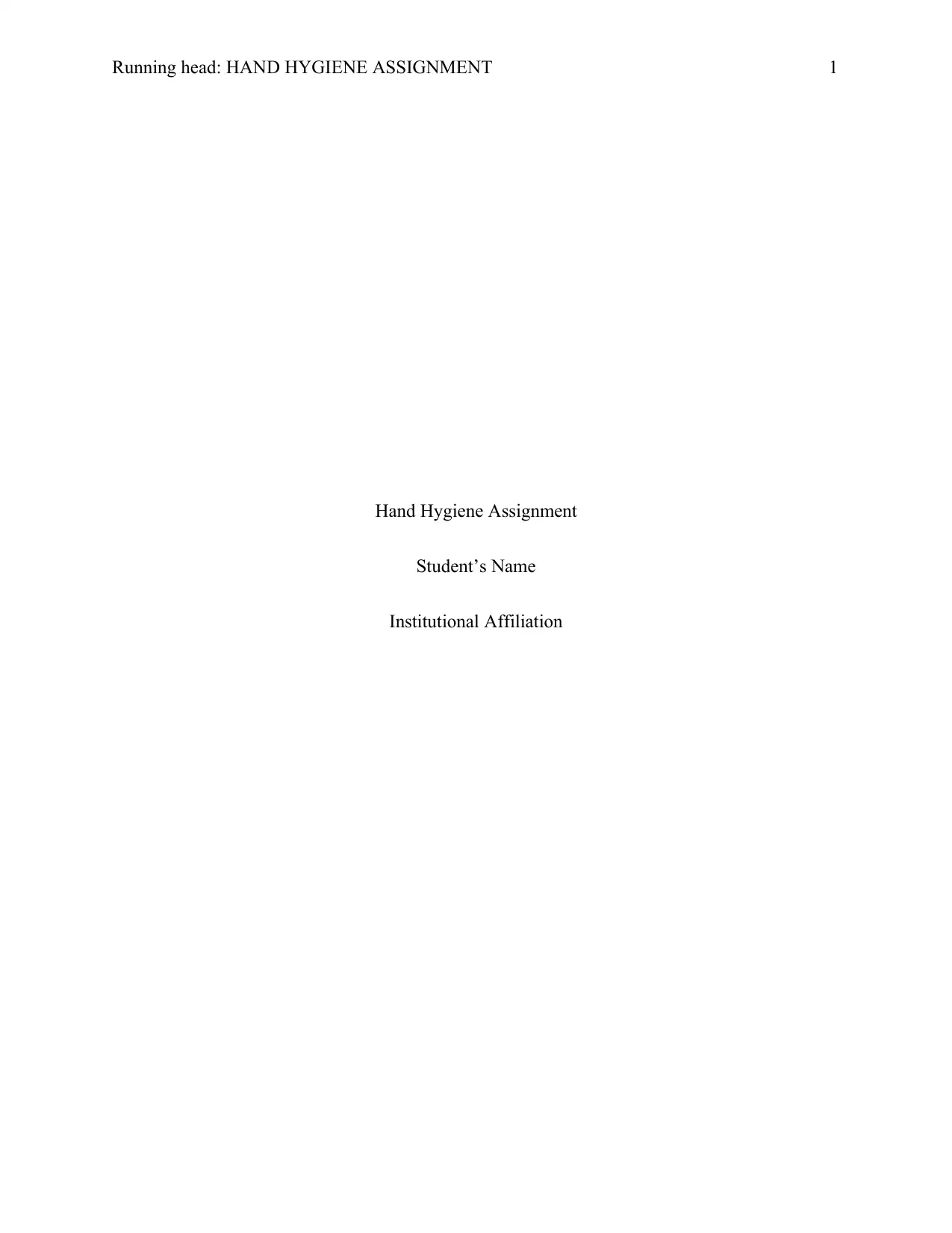
Running head: HAND HYGIENE ASSIGNMENT 1
Hand Hygiene Assignment
Student’s Name
Institutional Affiliation
Hand Hygiene Assignment
Student’s Name
Institutional Affiliation
Paraphrase This Document
Need a fresh take? Get an instant paraphrase of this document with our AI Paraphraser
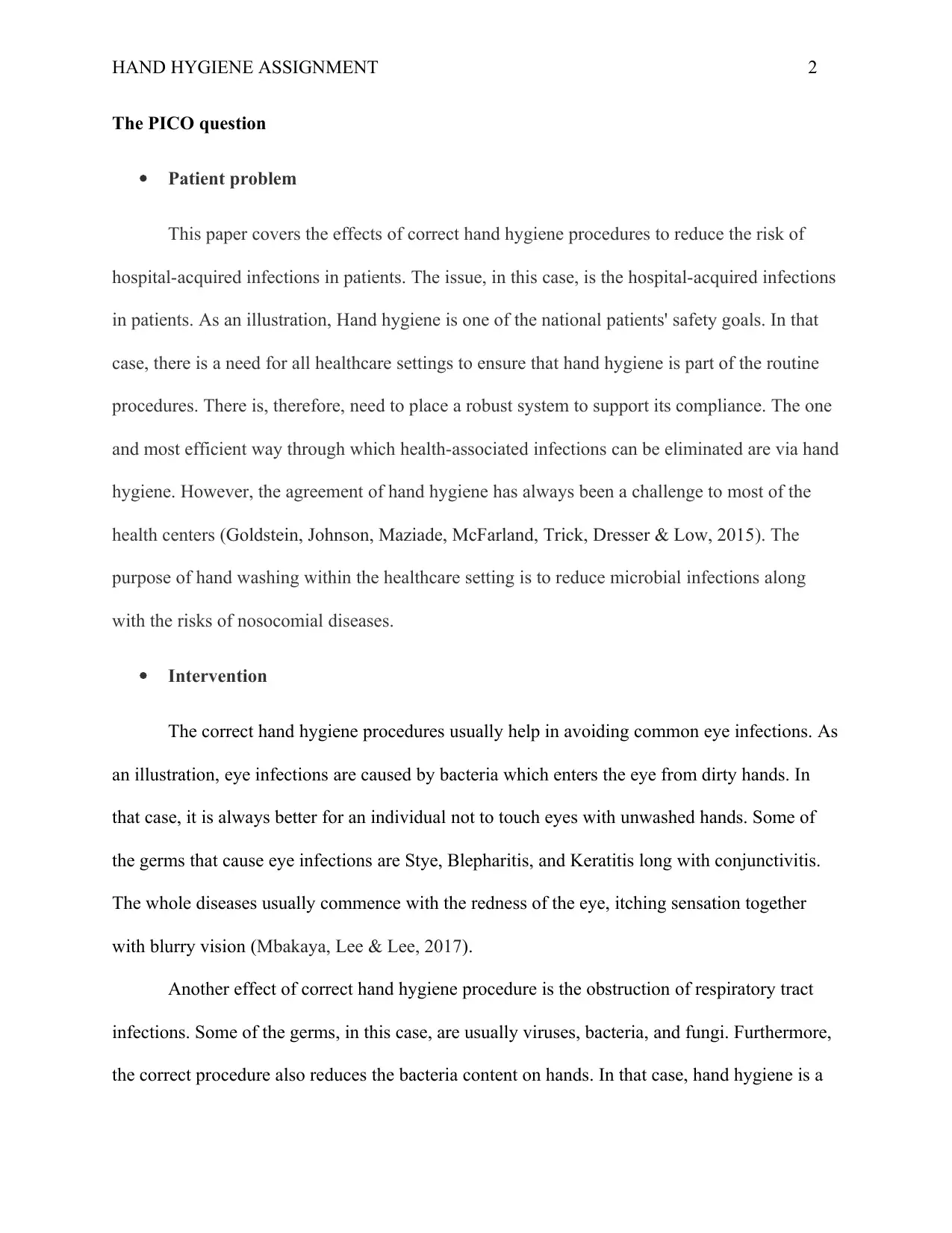
HAND HYGIENE ASSIGNMENT 2
The PICO question
Patient problem
This paper covers the effects of correct hand hygiene procedures to reduce the risk of
hospital-acquired infections in patients. The issue, in this case, is the hospital-acquired infections
in patients. As an illustration, Hand hygiene is one of the national patients' safety goals. In that
case, there is a need for all healthcare settings to ensure that hand hygiene is part of the routine
procedures. There is, therefore, need to place a robust system to support its compliance. The one
and most efficient way through which health-associated infections can be eliminated are via hand
hygiene. However, the agreement of hand hygiene has always been a challenge to most of the
health centers (Goldstein, Johnson, Maziade, McFarland, Trick, Dresser & Low, 2015). The
purpose of hand washing within the healthcare setting is to reduce microbial infections along
with the risks of nosocomial diseases.
Intervention
The correct hand hygiene procedures usually help in avoiding common eye infections. As
an illustration, eye infections are caused by bacteria which enters the eye from dirty hands. In
that case, it is always better for an individual not to touch eyes with unwashed hands. Some of
the germs that cause eye infections are Stye, Blepharitis, and Keratitis long with conjunctivitis.
The whole diseases usually commence with the redness of the eye, itching sensation together
with blurry vision (Mbakaya, Lee & Lee, 2017).
Another effect of correct hand hygiene procedure is the obstruction of respiratory tract
infections. Some of the germs, in this case, are usually viruses, bacteria, and fungi. Furthermore,
the correct procedure also reduces the bacteria content on hands. In that case, hand hygiene is a
The PICO question
Patient problem
This paper covers the effects of correct hand hygiene procedures to reduce the risk of
hospital-acquired infections in patients. The issue, in this case, is the hospital-acquired infections
in patients. As an illustration, Hand hygiene is one of the national patients' safety goals. In that
case, there is a need for all healthcare settings to ensure that hand hygiene is part of the routine
procedures. There is, therefore, need to place a robust system to support its compliance. The one
and most efficient way through which health-associated infections can be eliminated are via hand
hygiene. However, the agreement of hand hygiene has always been a challenge to most of the
health centers (Goldstein, Johnson, Maziade, McFarland, Trick, Dresser & Low, 2015). The
purpose of hand washing within the healthcare setting is to reduce microbial infections along
with the risks of nosocomial diseases.
Intervention
The correct hand hygiene procedures usually help in avoiding common eye infections. As
an illustration, eye infections are caused by bacteria which enters the eye from dirty hands. In
that case, it is always better for an individual not to touch eyes with unwashed hands. Some of
the germs that cause eye infections are Stye, Blepharitis, and Keratitis long with conjunctivitis.
The whole diseases usually commence with the redness of the eye, itching sensation together
with blurry vision (Mbakaya, Lee & Lee, 2017).
Another effect of correct hand hygiene procedure is the obstruction of respiratory tract
infections. Some of the germs, in this case, are usually viruses, bacteria, and fungi. Furthermore,
the correct procedure also reduces the bacteria content on hands. In that case, hand hygiene is a
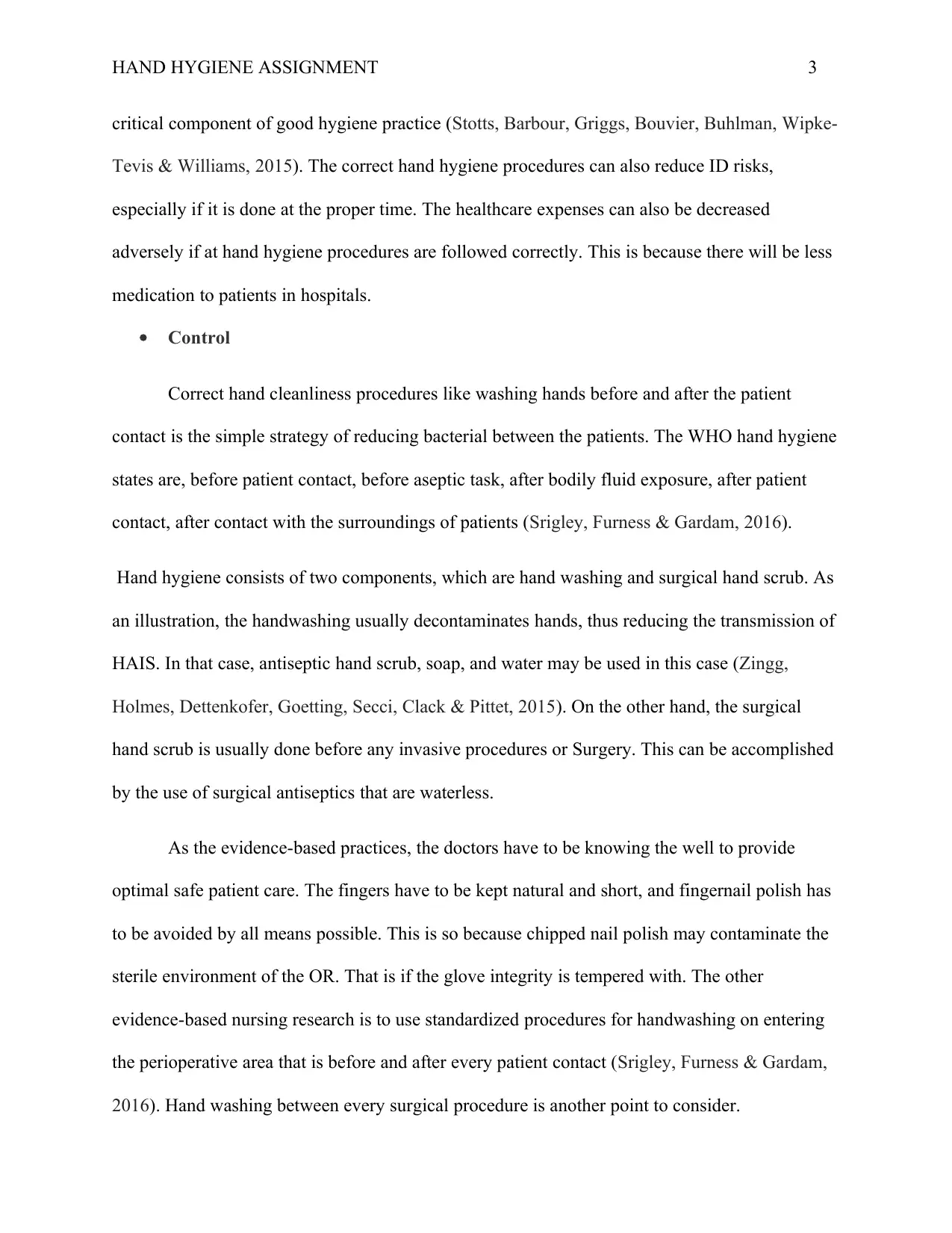
HAND HYGIENE ASSIGNMENT 3
critical component of good hygiene practice (Stotts, Barbour, Griggs, Bouvier, Buhlman, Wipke-
Tevis & Williams, 2015). The correct hand hygiene procedures can also reduce ID risks,
especially if it is done at the proper time. The healthcare expenses can also be decreased
adversely if at hand hygiene procedures are followed correctly. This is because there will be less
medication to patients in hospitals.
Control
Correct hand cleanliness procedures like washing hands before and after the patient
contact is the simple strategy of reducing bacterial between the patients. The WHO hand hygiene
states are, before patient contact, before aseptic task, after bodily fluid exposure, after patient
contact, after contact with the surroundings of patients (Srigley, Furness & Gardam, 2016).
Hand hygiene consists of two components, which are hand washing and surgical hand scrub. As
an illustration, the handwashing usually decontaminates hands, thus reducing the transmission of
HAIS. In that case, antiseptic hand scrub, soap, and water may be used in this case (Zingg,
Holmes, Dettenkofer, Goetting, Secci, Clack & Pittet, 2015). On the other hand, the surgical
hand scrub is usually done before any invasive procedures or Surgery. This can be accomplished
by the use of surgical antiseptics that are waterless.
As the evidence-based practices, the doctors have to be knowing the well to provide
optimal safe patient care. The fingers have to be kept natural and short, and fingernail polish has
to be avoided by all means possible. This is so because chipped nail polish may contaminate the
sterile environment of the OR. That is if the glove integrity is tempered with. The other
evidence-based nursing research is to use standardized procedures for handwashing on entering
the perioperative area that is before and after every patient contact (Srigley, Furness & Gardam,
2016). Hand washing between every surgical procedure is another point to consider.
critical component of good hygiene practice (Stotts, Barbour, Griggs, Bouvier, Buhlman, Wipke-
Tevis & Williams, 2015). The correct hand hygiene procedures can also reduce ID risks,
especially if it is done at the proper time. The healthcare expenses can also be decreased
adversely if at hand hygiene procedures are followed correctly. This is because there will be less
medication to patients in hospitals.
Control
Correct hand cleanliness procedures like washing hands before and after the patient
contact is the simple strategy of reducing bacterial between the patients. The WHO hand hygiene
states are, before patient contact, before aseptic task, after bodily fluid exposure, after patient
contact, after contact with the surroundings of patients (Srigley, Furness & Gardam, 2016).
Hand hygiene consists of two components, which are hand washing and surgical hand scrub. As
an illustration, the handwashing usually decontaminates hands, thus reducing the transmission of
HAIS. In that case, antiseptic hand scrub, soap, and water may be used in this case (Zingg,
Holmes, Dettenkofer, Goetting, Secci, Clack & Pittet, 2015). On the other hand, the surgical
hand scrub is usually done before any invasive procedures or Surgery. This can be accomplished
by the use of surgical antiseptics that are waterless.
As the evidence-based practices, the doctors have to be knowing the well to provide
optimal safe patient care. The fingers have to be kept natural and short, and fingernail polish has
to be avoided by all means possible. This is so because chipped nail polish may contaminate the
sterile environment of the OR. That is if the glove integrity is tempered with. The other
evidence-based nursing research is to use standardized procedures for handwashing on entering
the perioperative area that is before and after every patient contact (Srigley, Furness & Gardam,
2016). Hand washing between every surgical procedure is another point to consider.
⊘ This is a preview!⊘
Do you want full access?
Subscribe today to unlock all pages.

Trusted by 1+ million students worldwide
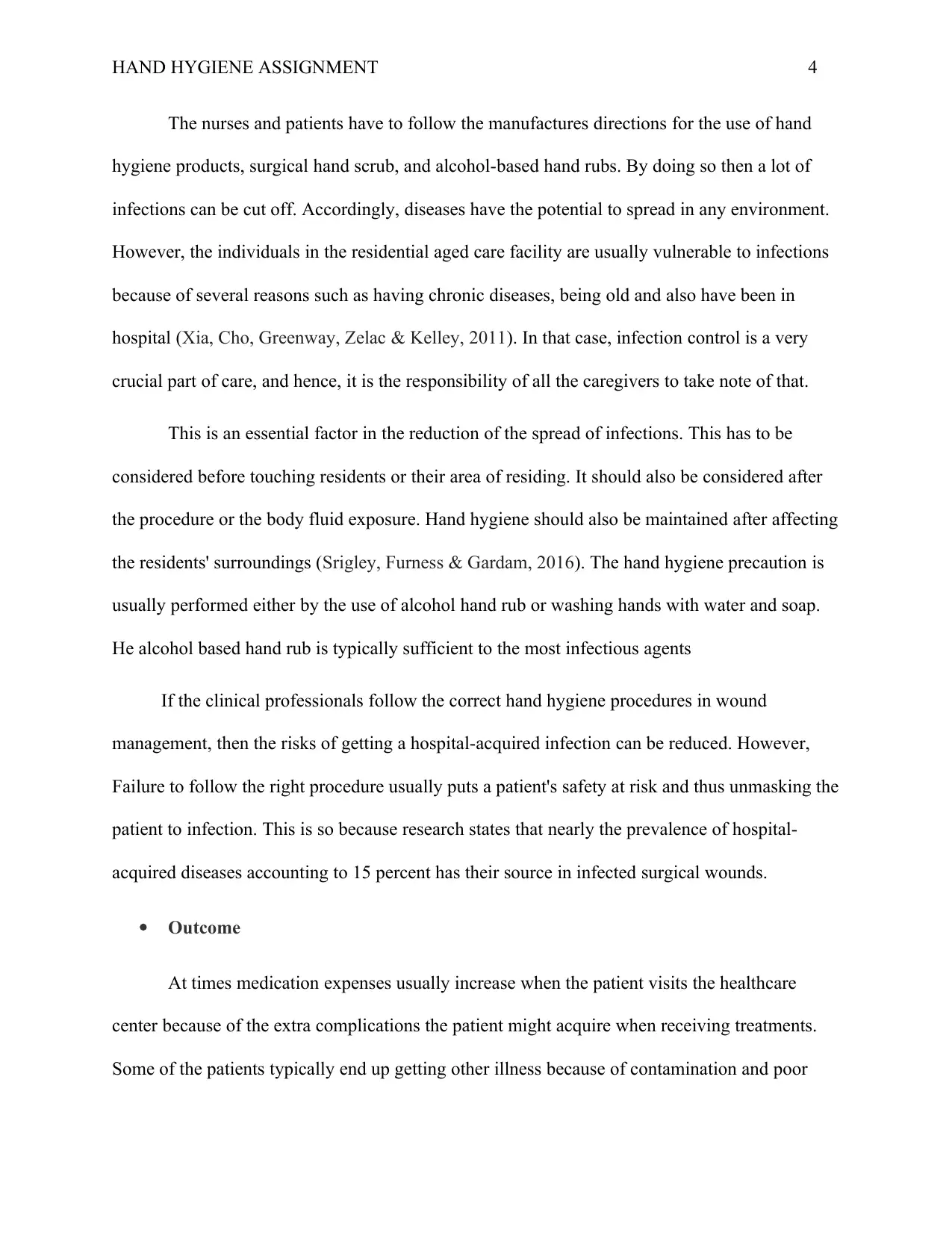
HAND HYGIENE ASSIGNMENT 4
The nurses and patients have to follow the manufactures directions for the use of hand
hygiene products, surgical hand scrub, and alcohol-based hand rubs. By doing so then a lot of
infections can be cut off. Accordingly, diseases have the potential to spread in any environment.
However, the individuals in the residential aged care facility are usually vulnerable to infections
because of several reasons such as having chronic diseases, being old and also have been in
hospital (Xia, Cho, Greenway, Zelac & Kelley, 2011). In that case, infection control is a very
crucial part of care, and hence, it is the responsibility of all the caregivers to take note of that.
This is an essential factor in the reduction of the spread of infections. This has to be
considered before touching residents or their area of residing. It should also be considered after
the procedure or the body fluid exposure. Hand hygiene should also be maintained after affecting
the residents' surroundings (Srigley, Furness & Gardam, 2016). The hand hygiene precaution is
usually performed either by the use of alcohol hand rub or washing hands with water and soap.
He alcohol based hand rub is typically sufficient to the most infectious agents
If the clinical professionals follow the correct hand hygiene procedures in wound
management, then the risks of getting a hospital-acquired infection can be reduced. However,
Failure to follow the right procedure usually puts a patient's safety at risk and thus unmasking the
patient to infection. This is so because research states that nearly the prevalence of hospital-
acquired diseases accounting to 15 percent has their source in infected surgical wounds.
Outcome
At times medication expenses usually increase when the patient visits the healthcare
center because of the extra complications the patient might acquire when receiving treatments.
Some of the patients typically end up getting other illness because of contamination and poor
The nurses and patients have to follow the manufactures directions for the use of hand
hygiene products, surgical hand scrub, and alcohol-based hand rubs. By doing so then a lot of
infections can be cut off. Accordingly, diseases have the potential to spread in any environment.
However, the individuals in the residential aged care facility are usually vulnerable to infections
because of several reasons such as having chronic diseases, being old and also have been in
hospital (Xia, Cho, Greenway, Zelac & Kelley, 2011). In that case, infection control is a very
crucial part of care, and hence, it is the responsibility of all the caregivers to take note of that.
This is an essential factor in the reduction of the spread of infections. This has to be
considered before touching residents or their area of residing. It should also be considered after
the procedure or the body fluid exposure. Hand hygiene should also be maintained after affecting
the residents' surroundings (Srigley, Furness & Gardam, 2016). The hand hygiene precaution is
usually performed either by the use of alcohol hand rub or washing hands with water and soap.
He alcohol based hand rub is typically sufficient to the most infectious agents
If the clinical professionals follow the correct hand hygiene procedures in wound
management, then the risks of getting a hospital-acquired infection can be reduced. However,
Failure to follow the right procedure usually puts a patient's safety at risk and thus unmasking the
patient to infection. This is so because research states that nearly the prevalence of hospital-
acquired diseases accounting to 15 percent has their source in infected surgical wounds.
Outcome
At times medication expenses usually increase when the patient visits the healthcare
center because of the extra complications the patient might acquire when receiving treatments.
Some of the patients typically end up getting other illness because of contamination and poor
Paraphrase This Document
Need a fresh take? Get an instant paraphrase of this document with our AI Paraphraser
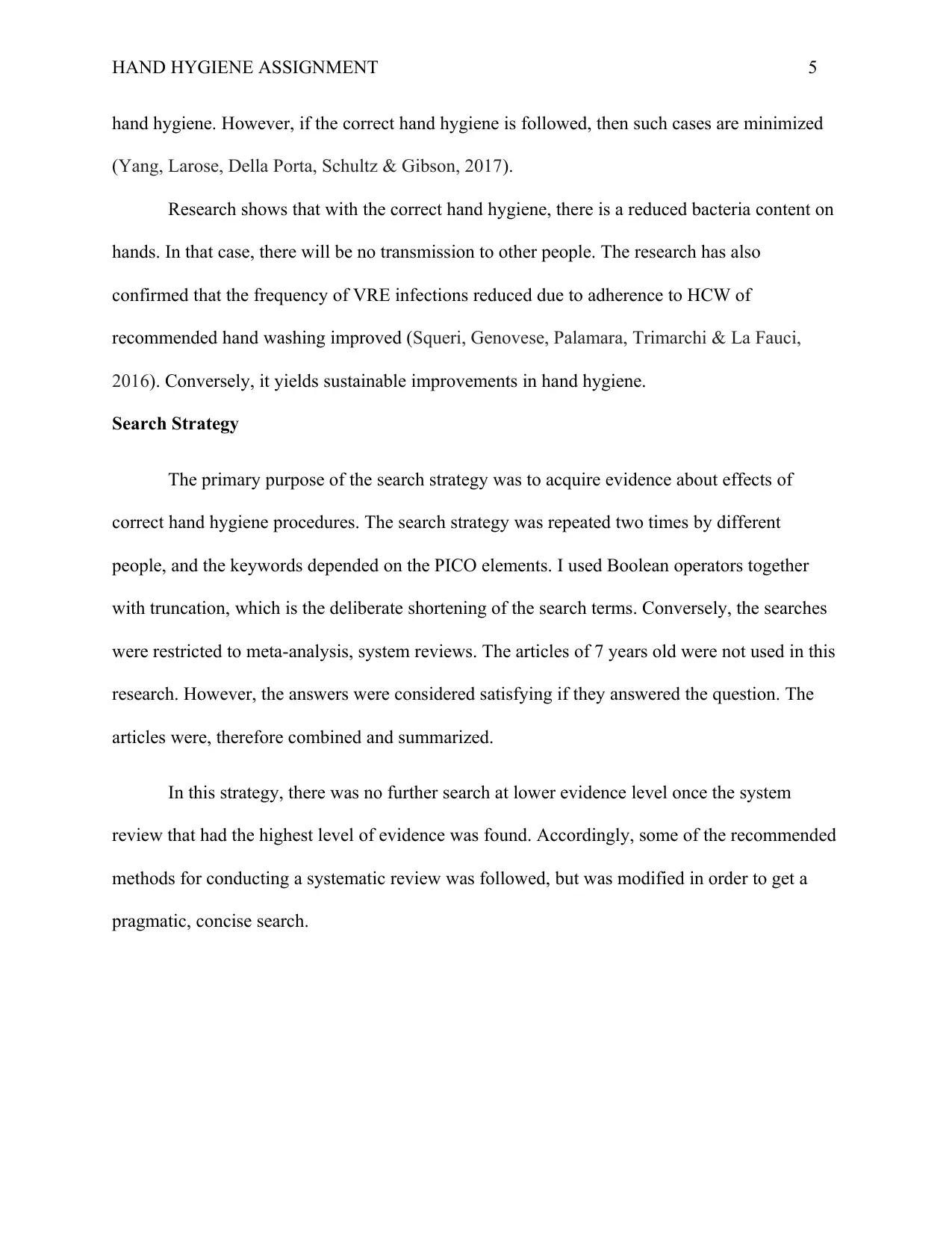
HAND HYGIENE ASSIGNMENT 5
hand hygiene. However, if the correct hand hygiene is followed, then such cases are minimized
(Yang, Larose, Della Porta, Schultz & Gibson, 2017).
Research shows that with the correct hand hygiene, there is a reduced bacteria content on
hands. In that case, there will be no transmission to other people. The research has also
confirmed that the frequency of VRE infections reduced due to adherence to HCW of
recommended hand washing improved (Squeri, Genovese, Palamara, Trimarchi & La Fauci,
2016). Conversely, it yields sustainable improvements in hand hygiene.
Search Strategy
The primary purpose of the search strategy was to acquire evidence about effects of
correct hand hygiene procedures. The search strategy was repeated two times by different
people, and the keywords depended on the PICO elements. I used Boolean operators together
with truncation, which is the deliberate shortening of the search terms. Conversely, the searches
were restricted to meta-analysis, system reviews. The articles of 7 years old were not used in this
research. However, the answers were considered satisfying if they answered the question. The
articles were, therefore combined and summarized.
In this strategy, there was no further search at lower evidence level once the system
review that had the highest level of evidence was found. Accordingly, some of the recommended
methods for conducting a systematic review was followed, but was modified in order to get a
pragmatic, concise search.
hand hygiene. However, if the correct hand hygiene is followed, then such cases are minimized
(Yang, Larose, Della Porta, Schultz & Gibson, 2017).
Research shows that with the correct hand hygiene, there is a reduced bacteria content on
hands. In that case, there will be no transmission to other people. The research has also
confirmed that the frequency of VRE infections reduced due to adherence to HCW of
recommended hand washing improved (Squeri, Genovese, Palamara, Trimarchi & La Fauci,
2016). Conversely, it yields sustainable improvements in hand hygiene.
Search Strategy
The primary purpose of the search strategy was to acquire evidence about effects of
correct hand hygiene procedures. The search strategy was repeated two times by different
people, and the keywords depended on the PICO elements. I used Boolean operators together
with truncation, which is the deliberate shortening of the search terms. Conversely, the searches
were restricted to meta-analysis, system reviews. The articles of 7 years old were not used in this
research. However, the answers were considered satisfying if they answered the question. The
articles were, therefore combined and summarized.
In this strategy, there was no further search at lower evidence level once the system
review that had the highest level of evidence was found. Accordingly, some of the recommended
methods for conducting a systematic review was followed, but was modified in order to get a
pragmatic, concise search.
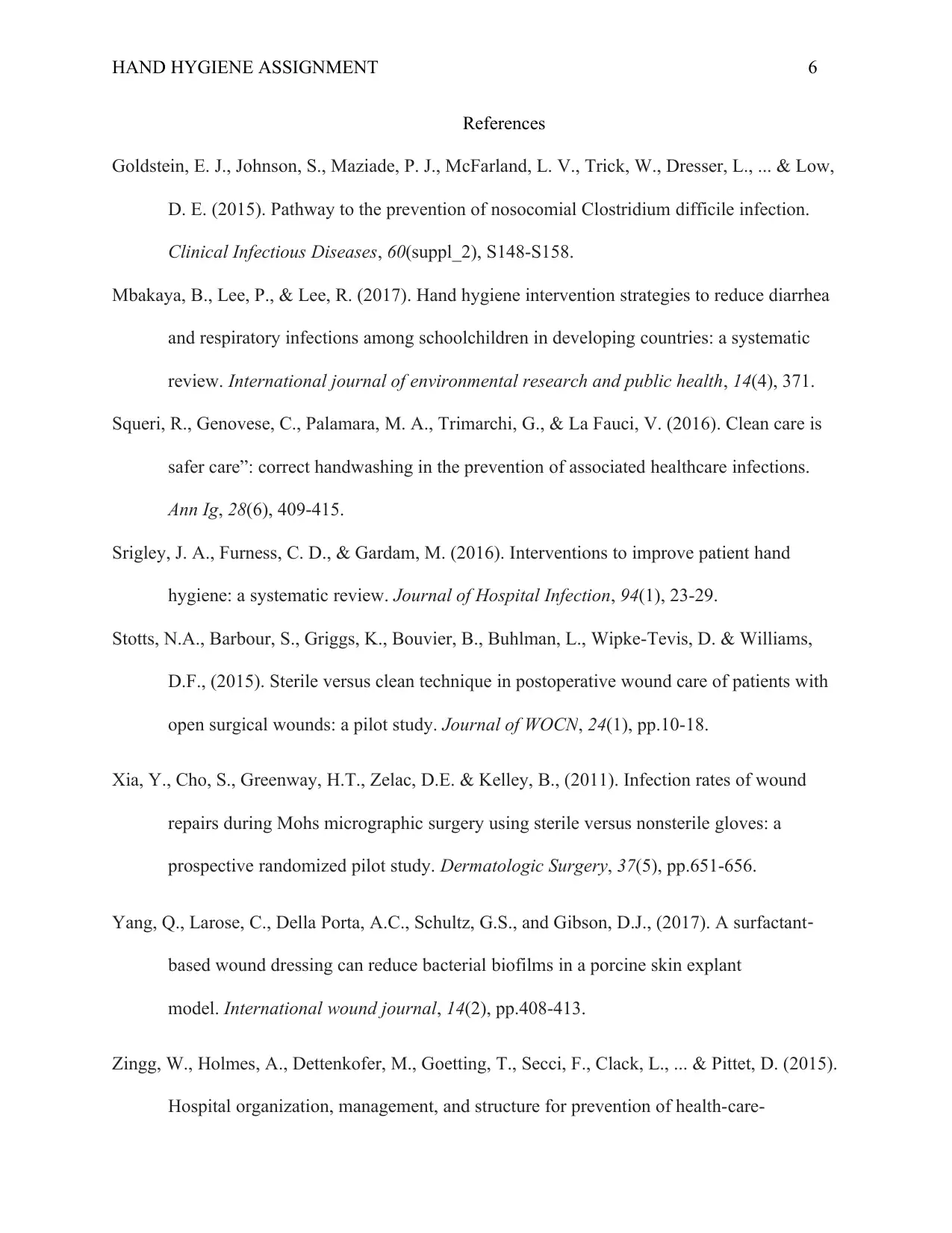
HAND HYGIENE ASSIGNMENT 6
References
Goldstein, E. J., Johnson, S., Maziade, P. J., McFarland, L. V., Trick, W., Dresser, L., ... & Low,
D. E. (2015). Pathway to the prevention of nosocomial Clostridium difficile infection.
Clinical Infectious Diseases, 60(suppl_2), S148-S158.
Mbakaya, B., Lee, P., & Lee, R. (2017). Hand hygiene intervention strategies to reduce diarrhea
and respiratory infections among schoolchildren in developing countries: a systematic
review. International journal of environmental research and public health, 14(4), 371.
Squeri, R., Genovese, C., Palamara, M. A., Trimarchi, G., & La Fauci, V. (2016). Clean care is
safer care”: correct handwashing in the prevention of associated healthcare infections.
Ann Ig, 28(6), 409-415.
Srigley, J. A., Furness, C. D., & Gardam, M. (2016). Interventions to improve patient hand
hygiene: a systematic review. Journal of Hospital Infection, 94(1), 23-29.
Stotts, N.A., Barbour, S., Griggs, K., Bouvier, B., Buhlman, L., Wipke-Tevis, D. & Williams,
D.F., (2015). Sterile versus clean technique in postoperative wound care of patients with
open surgical wounds: a pilot study. Journal of WOCN, 24(1), pp.10-18.
Xia, Y., Cho, S., Greenway, H.T., Zelac, D.E. & Kelley, B., (2011). Infection rates of wound
repairs during Mohs micrographic surgery using sterile versus nonsterile gloves: a
prospective randomized pilot study. Dermatologic Surgery, 37(5), pp.651-656.
Yang, Q., Larose, C., Della Porta, A.C., Schultz, G.S., and Gibson, D.J., (2017). A surfactant‐
based wound dressing can reduce bacterial biofilms in a porcine skin explant
model. International wound journal, 14(2), pp.408-413.
Zingg, W., Holmes, A., Dettenkofer, M., Goetting, T., Secci, F., Clack, L., ... & Pittet, D. (2015).
Hospital organization, management, and structure for prevention of health-care-
References
Goldstein, E. J., Johnson, S., Maziade, P. J., McFarland, L. V., Trick, W., Dresser, L., ... & Low,
D. E. (2015). Pathway to the prevention of nosocomial Clostridium difficile infection.
Clinical Infectious Diseases, 60(suppl_2), S148-S158.
Mbakaya, B., Lee, P., & Lee, R. (2017). Hand hygiene intervention strategies to reduce diarrhea
and respiratory infections among schoolchildren in developing countries: a systematic
review. International journal of environmental research and public health, 14(4), 371.
Squeri, R., Genovese, C., Palamara, M. A., Trimarchi, G., & La Fauci, V. (2016). Clean care is
safer care”: correct handwashing in the prevention of associated healthcare infections.
Ann Ig, 28(6), 409-415.
Srigley, J. A., Furness, C. D., & Gardam, M. (2016). Interventions to improve patient hand
hygiene: a systematic review. Journal of Hospital Infection, 94(1), 23-29.
Stotts, N.A., Barbour, S., Griggs, K., Bouvier, B., Buhlman, L., Wipke-Tevis, D. & Williams,
D.F., (2015). Sterile versus clean technique in postoperative wound care of patients with
open surgical wounds: a pilot study. Journal of WOCN, 24(1), pp.10-18.
Xia, Y., Cho, S., Greenway, H.T., Zelac, D.E. & Kelley, B., (2011). Infection rates of wound
repairs during Mohs micrographic surgery using sterile versus nonsterile gloves: a
prospective randomized pilot study. Dermatologic Surgery, 37(5), pp.651-656.
Yang, Q., Larose, C., Della Porta, A.C., Schultz, G.S., and Gibson, D.J., (2017). A surfactant‐
based wound dressing can reduce bacterial biofilms in a porcine skin explant
model. International wound journal, 14(2), pp.408-413.
Zingg, W., Holmes, A., Dettenkofer, M., Goetting, T., Secci, F., Clack, L., ... & Pittet, D. (2015).
Hospital organization, management, and structure for prevention of health-care-
⊘ This is a preview!⊘
Do you want full access?
Subscribe today to unlock all pages.

Trusted by 1+ million students worldwide
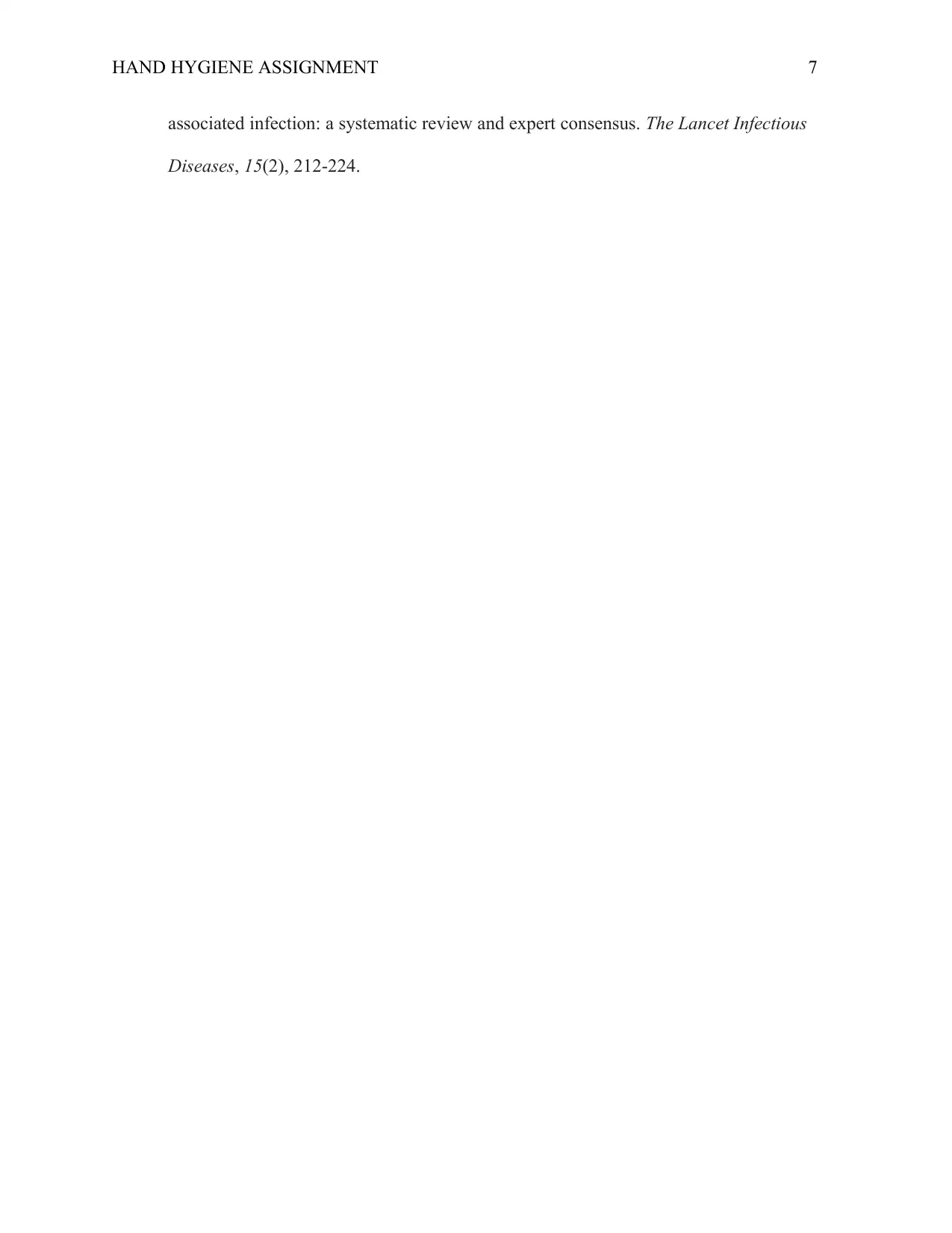
HAND HYGIENE ASSIGNMENT 7
associated infection: a systematic review and expert consensus. The Lancet Infectious
Diseases, 15(2), 212-224.
associated infection: a systematic review and expert consensus. The Lancet Infectious
Diseases, 15(2), 212-224.
1 out of 7
Related Documents
Your All-in-One AI-Powered Toolkit for Academic Success.
+13062052269
info@desklib.com
Available 24*7 on WhatsApp / Email
![[object Object]](/_next/static/media/star-bottom.7253800d.svg)
Unlock your academic potential
Copyright © 2020–2025 A2Z Services. All Rights Reserved. Developed and managed by ZUCOL.





